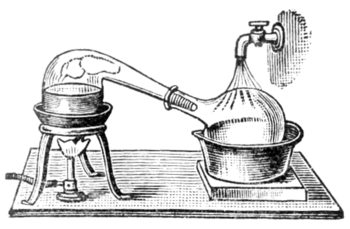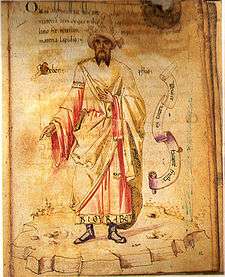Ebu Musa Câbir bin Hayyan
| Ebu Musa Câbir bin Hayyân ابو موسی جابربن حیان | |
|---|---|
|
Avrupa'da çizilmiş "Geber" (15. yüzyıl), Codici Ashburnhamiani 1166, Biblioteca Medicea Laurenziana, Florence | |
| Doğum |
Cābir ibn Hayyān 721/722 Horasan, İran |
| Ölüm |
808/815 Kufe, Irak |
| Yaşadığı yer | Abbâsî Halifeliği |
| Meslek | Fen, Simya, Eczacılık, Metalürji, Astroloji, Felsefe, Fizik ve Müzik |
| Dönem | İslam'ın Altın Çağı |
| Edebî akım | Felsefe, Sufilik, Matematik, Astroloji, Astronomi, Fizik, Kimya ve Ecza |
|
Etkiledikleri
| |
|
Etkilendikleri
| |
Ebû Mûsa Câbir bin Hayyân (Arapça: ابو موسی جابربن حیان, Latince: "Geber" ya da "Geberus"; (al-Barigi Kabilesi / al-Azdi / al-Kufi / al-Tusi / al-Sufi)[1], (doğum: 721, Tus, İran, Horasan; ölüm: 815, Kufe, Irak)[2] Batıda daha ziyâde Geber olarak tanınan, Abbâsîler döneminde yaşamış ve İslâmiyet'te fen bilimlerinin temelini atmış olan Farsî çok yönlü bir fen bilgini; simyacı, kimyacı ve eczacı; fizikçi, astronom ve astrolog; tıp ve fizik tedavi uzmanı; mühendis, coğrafyacı, filozof ve sûfi.
Hayâtı
Tus, İran'da eğitimini aldıktan sonra Kûfe'ye göç etti. Câbir bin Hayyân bilinen ilk pratik Simya (Alşimi) âlimdir.[3] Orta Çağ Avrupası'nın Simya alanına büyük ölçüde etki etmiş ve Kimya'nın da esasını oluşturmuştur. İmâm Câʿfer-i Sâdık'ın öğrencisidir.
İcâtları
Kimyager ve Eczacı olan bir babanın oğlu olarak Horasan'da doğmuş ve Yemen'de okuduktan sonra Kufe'ye giderek Abbâsî halifesi Harun Reşid'e saray âlimi olarak hizmet etmiştir.

Kimya dışında Eczacılık, Metalürji, Astroloji, Felsefe, Fizik ve Müzik gibi geniş alanda 400 ü aşan eser bıraktığı söylenirse de ancak 20 civarında eseri bugüne kalmıştır.
Nitrik asit, Hidrojen klorür ve Sülfürik asit'in rafine ve kristalize yöntemlerini bulduğu Kral suyu'nu icat ettiği ve Sitrik asit, Asetik asit, Tartarik asiti keşfetiği düşünülmektedir. "İmbik" ( الأنبيق al-inbiq) geliştirmiş ve kendisinin ortaya attığı Baz kavramıyla Kimya'nın gelişmesine katkıda bulunmuştur.
Ayrıca daha sonra zehirlilerin zehirlisi olan arsenik tozunu elde eden ilk kişidir.
Agathondaemon, Hermes Trismegistus, Pisagor ve Sokrates'i saydığı ve Eski Yunan, Eski Mısır ve Şia Sufizminden etkilendiği düşünülmektedir.
Eserlerinden 12. yüzyılında Latince'ye çevirilmiş olan Kitab al-Kimya adlı eseri, Simya ve Kimya kelimelerinin kökeni olmuştur.
Kaynakça
- ↑ S.N. Nasr, "Life Sciences, Alchemy and Medicine", The Cambridge History of Iran, Cambridge, Volume 4, 1975, p. 412: "Jabir is entitled in the traditional sources as al-Azdi, al-Kufi, al-Tusi, al-Sufi. There is a debate as to whether he was an Arab from Kufa who lived in Khurasan or a Persian from Khorasan who later went to Kufa or whether he was, as some have suggested, of Syrian origin and later lived in Persia and Iraq".
- ↑ "Abu Musa Jabir ibn Hayyan". Encyclopædia Britannica Online. 8 Mayıs 2008 tarihinde kaynağından arşivlendi. http://web.archive.org/web/20080508163842/http://www.britannica.com:80/eb/article-9043128/Abu-Musa-Jabir-ibn-Hayyan#261644.toc. Erişim tarihi: 11 February 2008.
- ↑ Julian, Franklyn, Dictionary of the Occult, Kessinger Publishing, 2003, ISBN 0-7661-2816-4, ISBN 978-0-7661-2816-3, p. 8.
Başvuru kitapları
- History of Analytical Chemistry By Ferenc Szabadváry,P 11,ISBN 2-88124-569-2.
- The Historical Background of Chemistry By Henry Marshall Leicester,P 63.
- Alchemy,Eric John Holmyard, P 68.
- Dragon's Brain Perfume an Historical Geography of Camphor, Robin Arthur Donkin, P 137.
- The Grand Contraption The World as Myth, Number, and Chance, David Allen Park, P 229.
- Cosmology in Gauge Field Theory and String Theory, By David Bailin, Alexander Love, P 181.
- The New Book of Knowledge, ISBN 0-7172-0517-7, Page 446.
- The Biology of Alcoholism, By Benjamin Kissin, Henri Begleiter,P 576.
- Medieval Science, Technology, and Medicine,By Thomas F. Glick, Steven John Livesey,Faith Wallis, ISBN 0-415-96930-1, P 280
- A History of Chemistry By Forris Jewett Moore, P 15.
- E. J. Brill's First Encyclopaedia of Islam, 1913-1936 By M. Th. Houtsma, E. van Donzel, ISBN 90-04-08265-4, P 989.
- In Old Paris, by Robert W. Berger, P 164, ISBN 0-934977-66-6.
- Chemical Essays By Richard Watson, P 68
- Jabir, Columbia Encyclopedia, Sixth Edition, 2007.
- Ahmad Y Hassan, Arabic Alchemy ya da Fars
- A Dictionary of the History of Science by Anton Sebastian - p. 241
- The Alchemical Body By David Gordon - p. 366
- The Structure and Properties of Matter by Herman Thompson Briscoe - p. 10
- The Tincal Trail: A History of Borax by Edward John Cocks, Norman J. Travis - p. 4
- William Royall Newman, Gehennical Fire: The Lives of George Starkey, an American Alchemist in the Scientific Revolution, Harvard University Press, 1994. pg 94: "According to traditional bio-bibliography of Muslims, Jabir ibn Hayyan was a Persian alchemist who lived at some time in the eight century and wrote a wealth of books on virtually every aspect of natural philosophy"
- William R. Newman, The Occult and Manifest Among the Alchemist", in F. J. Ragep, Sally P Ragep, Steven John Livesey, "Tradition, Transmission, Transformation: Proceedings of Two Conferences on pre-Modern science held at University of Oklahoma", Brill,1996/1997, pg 178:"This language of extracting the hidden nature formed an important lemma for the extensive corpus associated with the Persian alchemist Jabir ibn Hayyan"
- Henry Corbin, "The Voyage and the Messenger: Iran and Philosophy", Translated by Joseph H. Rowe,North Atlantic Books, 1998. pg 45: "The Nisba al-Azdin certainly does not necessarily indicate Arab origin. Geber seems to have been a client of the Azd tribe established in Kufa
- Tamara M. Green, "The City of the Moon God: Religious Traditions of Harran (Religions in the Graeco-Roman World) ", Brill, 1992. pg 177: "His most famous student was the Persian Jabir ibn Hayyan (b. circa 721 C.E.), under whose name the vast corpus of alchemical writing circulated in the medieval period in both the east and west, although many of the works attributed to Jabir have been demonstrated to be likely product of later Ismaili' tradition."
- David Gordon White, "The Alchemical Body: Siddha Traditions in Medieval India", University of Chicago Press, 1996. pg 447
- William R. Newman, Promethean Ambitions: Alchemy and the Quest to Perfect Nature, University of Chicago Press, 2004. pg 181: "The corpus ascribed to the eight-century Persian sage Jabir ibn Hayyan.."
- Wilbur Applebaum, The Scientific revolution and the foundation of modern science, Greenwood Press, 1995. pg 44: "The chief source of Arabic alchemy was associated with the name, in its Latinized form, of Geber, an eighth-century Persian."
- Neil Kamil,Fortress of the Soul: Violence, Metaphysics, and Material Life in the Huguenots New World, 1517-1751 (Early America: History, Context, Culture), JHU Press, 2005. pg 182: "The ninth-century Persian alchemist Jabir ibn Hay- yan, also known as Geber, is accurately called pseudo-Geber since most of the works published under this name in the West were forgeries"
- Aleksandr Sergeevich Povarennykh, Crystal Chemical Classification of Minerals, Plenum Press, 1972, v.1, ISBN 0-306-30348-5, page 4: The first to give separate consideration to minerals and other inorganic substances were the following: The Persian alchemist Jabir (721-815)...
- George Sarton, Introduction to the History of Science, Pub. for the Carnegie Institution of Washington, by the Williams & Wilkins Company, 1931, vol.2 pt.1, page 1044: Was Geber, as the name would imply, the Persian alchemist Jabir ibn Haiyan?
- Dan Merkur, in The psychoanalytic study of society (eds. Bryce Boyer, et al.), vol. 18, Routledge, ISBN 0-88163-161-2, page 352: I would note that the Persian alchemist Jabir ibn Hayyan developed the theory that all metals consist of different "balances" ...
- Anthony Gross, The Dissolution of the Lancastrian Kingship: Sir John Fortescue and the Crisis of Monarchy in Fifteenth-century England, Paul Watkins, 1996, ISBN 1-871615-90-9, page 19: Ever since the Seventy Books attributed to the Persian alchemist Jabir Ibn Hayyan had been translated into Latin .... Sebastian, Anton,A Dictionary of the History of Science, (Casterton Hall: Parthenon Publishing Group Ltd, 2001),241. Geber or Jabir is held to be the first practical alchemist. Julian, Franklyn, Dictionary of the Occult, Kessinger Publishing, 2003, ISBN 0-7661-2816-4, 9780766128163, p. 8.
| ||||||||||||||||||||||||||||||||||||||
|

